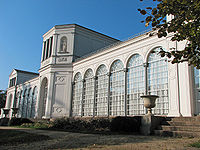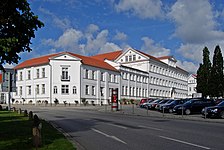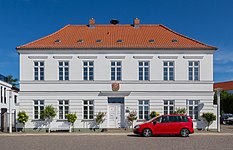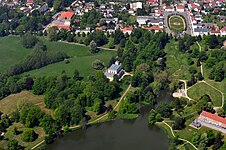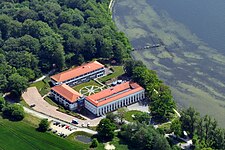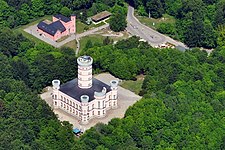Wilhelm Malte I.

Wilhelm Malte I, Prince of Putbus (born August 1, 1783 in Putbus ; † September 26, 1854, ibid) was a German prince from the old Slavic-Rügen noble family of the Lords of Putbus . He acted as the Swedish governor in Pomerania and later, under Prussian rule, as chairman of the municipal parliament of New West Pomerania and Rügen .
Through extensive building activity in the classicism style with Berlin influences, Wilhelm Malte I left many traces on the island of Rügen in the first half of the 19th century . He founded his princely residence Putbus in 1810 and pursued a deliberate settlement policy for the place, which 150 years later was granted city rights.
Life
Wilhelm Malte was born as the son of the Swedish court marshal Count Malte Friedrich zu Putbus and his wife Sophie Wilhelmine, née Countess von der Schulenburg, from the Beetzendorf house when Rügen was still part of Sweden as a result of the Thirty Years War , as part of Swedish Pomerania . He was only three years old when his father died and he received the inheritance and with it the dignity of the hereditary marshal. After studying at the universities of Greifswald and Göttingen , he joined Swedish services in the July 21, 1800 Stockholm hussars .
After becoming Swedish Chamberlain on September 14, 1802 , Wilhelm Malte was elevated to the status of prince by King Gustav IV Adolf of Sweden on May 25, 1807 . At the Greifswald state parliament in August 1806, the king had introduced the progressive Swedish constitution for Swedish-Western Pomerania, too, and thus met resistance from the local nobility. With the young Wilhelm Malte, he therefore brought in a “Swedish-influenced” Governor General, who was to become the primus inter pares of the West Pomeranian estates , not least because of his historically founded title of prince . After the end of the French occupation, he was appointed Governor General of Swedish Pomerania in 1813 by the ruling Swedish Crown Prince Karl Johann Bernadotte . Traditionally connected with this was the office of Chancellor of the University of Greifswald .
As a result of the Peace of Kiel , Rügen became Danish for a short time in 1814 and became part of Prussia in 1815, not least through the participation of the prince, as part of an exchange of territory at the Congress of Vienna . In 1817, King Friedrich Wilhelm III confirmed him . the prince status also for Prussia and also the dignity of a hereditary land marshal , governor general and university chancellor . He was now also chairman of the municipal parliament for New Western Pomerania and Rügen and received a viril vote in the provincial parliament . In the same year he acquired the Spyker estate from Count Magnus Fredrik Brahe . He retained the title of governor-general and the corresponding content since appointment as district president of the administrative district of Stralsund would be tantamount to a circumcision of his powers.

He officially carried the title of "Royal Governor General of the Provincial Authority of New West Pomerania". He was a member of the High Council of State, Chancellor of the royal Academy in Greifswald, he was Lieutenant General and Chief of the 2nd Landwehr Regiment. He was a knight of the Red Eagle Order and the Order of St. John, as well as commander of the royal. Swedish Order of the North Star and the Order of the Sword .
King Friedrich Wilhelm III. entrusted him with diplomatic missions, such as the one for the coronation of the British Queen Victoria .
During his reign there was brisk building activity with the participation of the Prussian court architects Schinkel , Stüler and Steinmeyer (including the classicistic renovation of the castle in Putbus , the construction of a theater , stables, orangery , circus, castle church , pedagogy , bathhouse Goor , etc.) Left unmistakable traces on the island of Rügen to this day, it came to a cultural and economic boom. Prince Putbus was involved in sugar and chalk factories, had shipbuilding carried out in Seedorf and founded Lauterbach , named after his wife's family, the first seaside resort on Rügen. He made 655 hectares of land with indivisible Bauer points in leasehold aufsiedeln. In addition, in 1836 he laid the foundation for a continuing education and training tradition in Putbus with the establishment of the Putbus pedagogy , a training institute for boys from the bourgeoisie and the nobility.
In 1847 he was a member of the First United State Parliament . In 1850 he was a member of the state house of the Erfurt Union Parliament . In 1854 the prince succumbed to a bladder problem after a long illness. He was buried in the family crypt of the Putbus family in the church of Vilmnitz .
progeny
Wilhelm Malte I. married Sophie Friederike Wilhelmine Luise von Lauterbach on August 16, 1806 in Frankfurt am Main (* October 7, 1784 in Frankfurt am Main; † September 27, 1860 in Putbus). Luise von Lauterbach had previously been married to Count Röttger von Veltheim (1781–1848) from 1802 , from whom she divorced in 1806 in order to be able to marry Wilhelm Malte I. The daughter Ottonie von Veltheim (born July 28, 1805; later married to Otto August Freiherr von Veltheim) came from their first marriage. Princess Luise's first husband was a well-known hippologist who remarried to Charlotte Antonie Friederike von Bülow in 1808 . When she died in 1848, he shot himself on the same day.
Wilhelm Malte I. and Luise von Lauterbach had their first-born son Malte (* September 16, 1807; † April 28, 1837), daughters Countess Clothilde zu Putbus (* April 25, 1809; † October 19, 1894), married to Graf Hermann Friedrich von Wylich and Lottum (1796–1849), and Countess Asta Luise zu Putbus (* 1812; † 1850). She married Franz Georg Albert Carl von Veltheim (1812–1874).
With Wilhelm Malte I, the Putbus family died out because of the early death of his only son Malte in the male line entitled to succession. Succession right because his son left a natural son : Carl August Malte Baison, who, however, as the adoptive son of his grandmother, Princess Luise zu Putbus, received royal Prussian nobility legitimation in 1854 and from then on was allowed to use her noble maiden name von Lauterbach .
Princely title and majorate ownership passed to Wilhelm Maltes grandson Wilhelm Carl Gustav Malte , Count von Wylich and Lottum (* April 16, 1833 - April 18, 1907), son of his eldest daughter Clothilde, who was given the name Wilhelm Malte II with royal confirmation . Prince and Lord zu Putbus accepted.
Pictures of the princely buildings on Rügen
Putbus Castle , blown up in 1962, demolished in 1964
See also
literature
- Kurt von Priesdorff : Soldier leadership . Volume 4, Hanseatische Verlagsanstalt Hamburg, undated [Hamburg], undated [1937], DNB 367632799 , pp. 141-142, no. 1269.
- André Farin: Wilhelm Malte zu Putbus and his royal residence on the island of Rügen. A biography about a north German founder personality of the 19th century. 5th enlarged edition. Putbus 2012, ISBN 978-3-00-008844-5 .
- Johannes Friedrich Weise: Between beach life and agriculture. Putbus reign in the 19th century. Ingo Koch Verlag, Rostock 2003, ISBN 3-935319-93-2 .
- Theodor Pyl : Putbus, from . In: Allgemeine Deutsche Biographie (ADB). Volume 26, Duncker & Humblot, Leipzig 1888, pp. 738-742. - mentioned in the family article
- Martin Schoebel : Putbus. In: New German Biography (NDB). Volume 21, Duncker & Humblot, Berlin 2003, ISBN 3-428-11202-4 , pp. 16-18 ( digitized version ).
- Jochen Lengemann : The German Parliament (Erfurt Union Parliament) from 1850. A manual: Members, officials, life data, parliamentary groups (= publications of the Historical Commission for Thuringia. Large series, Vol. 6). Urban & Fischer, Munich 2000, ISBN 3-437-31128-X , p. 241 ff.
Web links
- Literature by and about Wilhelm Malte I. in the catalog of the German National Library
- Literature about Wilhelm Malte I. in the state bibliography MV
- Rambow genealogy: life story of the Malte prince and lord zu Putbus
Individual evidence
- ↑ The Putbus house is said to have descended from the once sovereign Rügen dynasty.
- ^ Norbert Buske : Pomerania - territorial state and part of Prussia: an overview of the political development . Thomas Helms, Schwerin 1997, ISBN 3-931185-07-9 , p. 65.
- ^ A b Johannes Weise: The integration of Swedish Pomerania into the Prussian State Association: Transformation processes within the state and society . GRIN Verlag, 2008, ISBN 978-3-638-91521-2 , p. 205.
- ^ Provincial calendar for New Pomerania and the Principality of Rügen for the common year 1834. Government printing office, Stralsund 1834.
- ↑ a b Martin Schoebel: Putbus. In: New German Biography (NDB). Volume 21, Duncker & Humblot, Berlin 2003, ISBN 3-428-11202-4 , pp. 16-18 ( digitized version ).
- ^ Bernhard von Poten : Veltheim, Röttger Graf von . In: Allgemeine Deutsche Biographie (ADB). Volume 39, Duncker & Humblot, Leipzig 1895, p. 594 f.
- ↑ Uni Magdeburg biographies: Veltheim, Röttger Graf (since 1798) von
- ^ Genealogical handbook of the nobility . Adelslexikon Volume VII, Limburg / Lahn 1989, p. 97.
| personal data | |
|---|---|
| SURNAME | Wilhelm Malte I. |
| ALTERNATIVE NAMES | Wilhelm Malte I, Prince of Putbus |
| BRIEF DESCRIPTION | Prince on Rügen, Swedish governor in Pomerania |
| DATE OF BIRTH | August 1, 1783 |
| PLACE OF BIRTH | Putbus |
| DATE OF DEATH | September 26, 1854 |
| Place of death | Putbus |




